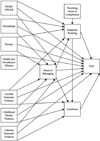Considering a Relational Model for Depression in Women with Postpartum Depression
- PMID: 25705566
- PMCID: PMC4334160
- DOI: 10.1891/2156-5287.4.3.151
Considering a Relational Model for Depression in Women with Postpartum Depression
Abstract
Purpose: To extend testing of a relational theory that a low sense of belonging, delayed or impaired bonding, and loneliness are salient risk factors for postpartum depression (PPD) in women.
Methods: Data for this theory-testing analysis came from a larger prospective longitudinal cohort study and included women who were retained to the end of the study at the 6 week postpartum interview (n=564). Structural equation modeling was used to test the "fit" of the model and determine significance of direct and indirect paths.
Results: The model explained 35% of the variance in postpartum depression with impaired bonding and loneliness as the strongest indicators. Lower sense of belonging, less perceived social support from a healthcare practitioner and a partner, and lower parenting sense of competence were additional predictors.
Conclusion: Study findings challenge current thinking about the relationship between impaired bonding and PPD as this study raises the possibility that impaired bonding is a risk for PPD as opposed to the reverse relationship. The study provided evidence of the importance of healthcare practitioners' alliance with patients. This paper contributes to advancing the science of women's mental health in relation to depression by considering additional predictors which might be amenable to intervention.
Keywords: bonding; conflict; loneliness; postpartum depression; sense of belonging; social support.
Figures


Similar articles
-
Considering a relational model for depression in Navy recruits.Mil Med. 2014 Nov;179(11):1293-300. doi: 10.7205/MILMED-D-14-00116. Mil Med. 2014. PMID: 25373057
-
Is the Effect of Postpartum Depression on Mother-Infant Bonding Universal?Infant Behav Dev. 2018 May;51:15-23. doi: 10.1016/j.infbeh.2018.02.003. Epub 2018 Mar 10. Infant Behav Dev. 2018. PMID: 29533871
-
The effects of sense of belonging, social support, conflict, and loneliness on depression.Nurs Res. 1999 Jul-Aug;48(4):215-9. doi: 10.1097/00006199-199907000-00004. Nurs Res. 1999. PMID: 10414684
-
New parents' experiences of postpartum depression: a systematic review of qualitative evidence.JBI Database System Rev Implement Rep. 2019 Sep;17(9):1731-1769. doi: 10.11124/JBISRIR-2017-003909. JBI Database System Rev Implement Rep. 2019. PMID: 31021977
-
Screening for depression and help-seeking in postpartum women during well-baby pediatric visits: an integrated review.J Pediatr Health Care. 2012 Mar;26(2):109-17. doi: 10.1016/j.pedhc.2010.06.012. Epub 2010 Aug 11. J Pediatr Health Care. 2012. PMID: 22360930 Review.
Cited by
-
Relationship-Building Skills of Child-Rearing Mothers in Japanese Communities.Nurs Res Pract. 2016;2016:9091039. doi: 10.1155/2016/9091039. Epub 2016 Jun 26. Nurs Res Pract. 2016. PMID: 27429804 Free PMC article.
-
Experiencing loneliness in parenthood: a scoping review.Perspect Public Health. 2021 Jul;141(4):214-225. doi: 10.1177/17579139211018243. Perspect Public Health. 2021. PMID: 34286652 Free PMC article.
-
Loneliness in Pregnancy and Parenthood: Impacts, Outcomes, and Costs.Yale J Biol Med. 2024 Mar 29;97(1):93-98. doi: 10.59249/NKTK3337. eCollection 2024 Mar. Yale J Biol Med. 2024. PMID: 38559456 Free PMC article. Review.
-
Mattering and Depressive Symptoms in Portuguese Postpartum Women: The Indirect Effect of Loneliness.Int J Environ Res Public Health. 2022 Sep 16;19(18):11671. doi: 10.3390/ijerph191811671. Int J Environ Res Public Health. 2022. PMID: 36141944 Free PMC article.
-
Psychometric testing of the Chinese version of the Perinatal Infant Care Social Support tool: a methodological study.Womens Health Nurs. 2024 Jun;30(2):128-139. doi: 10.4069/whn.2024.05.21. Epub 2024 Jun 28. Womens Health Nurs. 2024. PMID: 38987917 Free PMC article.
References
-
- Anant SS. Belongingness and mental health: Some research findings. Acta Psychologica. 1967;26:391–396. - PubMed
-
- Ashman S, Dawson G, Panagiotides H. Trajectories of maternal depression over 7 years: Relations with child psychophysiology and behavior and role of contextual risks. Development and Psychopathology. 2008;20:55–77. - PubMed
-
- Baker J, Mancuso x, Montenegro M, Lyons BA. Treating postpartum depression. Physician Assistant. 2002;26:37–44.
-
- Banti S, Borri C, Camilleri V, Cortopassi C, Montagnani MS, Ramacciotti D, Mauri M. Perinatal mood and anxiety disorders. clinical assessment and management. A review of current literature. Giornale Italiano Di Psicopatologia/ Italian Journal of Psychopathology. 2009;15(4):351–366.
-
- Beck CT. The lived experience of postpartum depression: A henomenological study. Nursing Research. 1992;41(3):166–170. - PubMed
Grants and funding
LinkOut - more resources
Full Text Sources
Other Literature Sources
